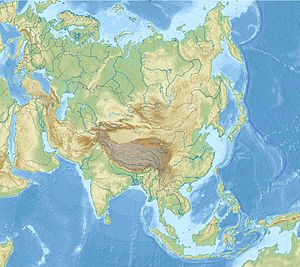| Pazyryk burials | |
|---|---|
 Pazyryk burial from Baga Turgen Gol site: a man in a wooden coffin, next to his horse. Bayan-Ölgiy province, Western Mongolia.[1] | |
| Material | Tombs |
| Created | 4th-3rd century BCE |
| Discovered | Pazyryk, 50°44′47″N 88°04′21″E / 50.746389°N 88.072500°E |

The Pazyryk[a] burials are a number of Scythian (Saka)[3][4][5] Iron Age tombs found in the Pazyryk Valley and the Ukok plateau in the Altai Mountains, Siberia, south of the modern city of Novosibirsk, Russia; the site is close to the borders with China, Kazakhstan and Mongolia.[6]
Numerous comparable burials have been found in neighbouring western Mongolia.
The tombs are Scythian-type kurgans, barrow-like tomb mounds containing wooden chambers covered over by large cairns of boulders and stones, dated to the 4th–3rd centuries BCE.[7] The spectacular burials at Pazyryk are responsible for the introduction of the term kurgan, a Russian word, into general usage to describe these tombs. The region of the Pazyryk kurgans is considered the type site of the wider Pazyryk culture. The site is included in the Golden Mountains of Altai UNESCO World Heritage Site.[8]
The bearers of the Pazyryk culture were horse-riding pastoral nomads of the steppe, and some may have accumulated great wealth through horse trading with merchants in Persia, India and China.[9] This wealth is evident in the wide array of finds from the Pazyryk tombs, which include many rare examples of organic objects such as felt hangings, Chinese silk, the earliest known pile carpet, horses decked out in elaborate trappings, and wooden furniture and other household goods. These finds were preserved when water seeped into the tombs in antiquity and froze, encasing the burial goods in ice, which remained frozen in the permafrost until the time of their excavation.
Because of a freak climatic freeze, some of the Altai-Sayan burials, notably those of the 5th century BCE at Pazyryk and neighbouring sites, such as Katanda, Shibe, and Tuekta, were isolated from external climatic variations by a protective layer of ice that conserved the organic substances buried in them. Certain geometric designs and sun symbols, such as the circle and rosette, recur at Pazyryk but are completely outnumbered by animal motifs. Such specifically Scythian features as zoomorphic junctures, i.e. the addition of a part of one animal to the body of another, are rarer in the Altaic region than in southern Russia. The stag and its relatives, however, figure as prominently in Altai-Sayan as in Scythian art.[10]
"At Pazyryk too are found bearded mascarons (masks) of well-defined Greco-Roman origin, which were doubtless inspired by the Hellenistic kingdoms of the Cimmerian Bosporus."[11]
- ^ González-Ruiz, Mercedes (9 November 2012). "Tracing the Origin of the East-West Population Admixture in the Altai Region (Central Asia)". PLOS ONE. 7 (11): e48904. Bibcode:2012PLoSO...748904G. doi:10.1371/journal.pone.0048904. ISSN 1932-6203. PMC 3494716. PMID 23152818.
- ^ Atwood, Christopher P.; Andreeva, Petya (2018). "Camp and audience scenes in late iron age rock drawings from Khawtsgait, Mongolia". Archaeological Research in Asia. 15: 4.
- ^ de Laet & Herrmann 1996, p. 443 "The rich kurgan burials in Pazyryk, Siberia probably were those of Saka chieftains"
- ^ Kuzmina 2008, p. 94 "Analysis of the clothing, which has analogies in the complex of Saka clothes, particularly in Pazyryk, led Wang Binghua (1987, 42) to the conclusion that they are related to the Saka Culture."
- ^ Kuzmina 2007, p. 103 "The dress of Iranian-speaking Saka and Scythians is easily reconstructed on the basis of... numerous archaeological discoveries from the Ukraine to the Altai, particularly at Issyk in Kazakhstan... at Pazyryk... and Ak-Alakha"
- ^ "Ice Mummies: Siberian Ice Maiden". PBS – NOVA. Retrieved 2009-09-01.
- ^ A Special Issue on the Dating of Pazyryk. Source: Notes in the History of Art 10, no. 4, p. 4.
- ^ "Golden Mountains of Altai". UNESCO. Retrieved 2007-07-31.
- ^ Bahn, Paul G. (2000). The Atlas of World Geology. New York: Checkmark Books. pp. 128. ISBN 0-8160-4051-6.
- ^ "Altaic Tribes". Encyclopædia Britannica Online. Encyclopædia Britannica. Retrieved December 5, 2016.
- ^ Grousset, Rene (1970). The Empire of the Steppes. Rutgers University Press. pp. 18–19. ISBN 0-8135-1304-9.
Cite error: There are <ref group=lower-alpha> tags or {{efn}} templates on this page, but the references will not show without a {{reflist|group=lower-alpha}} template or {{notelist}} template (see the help page).


